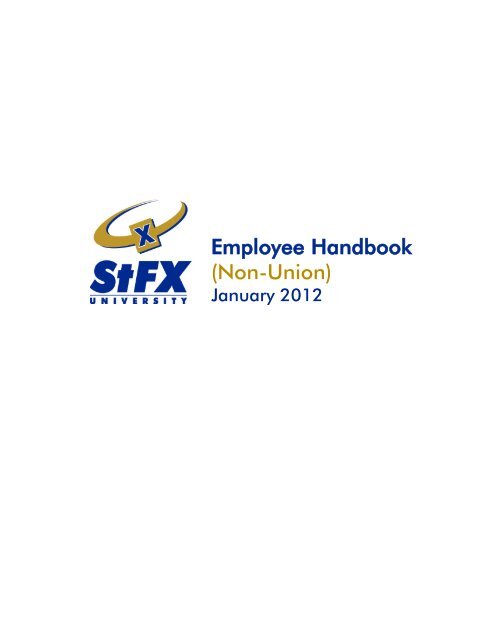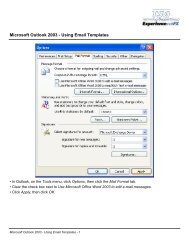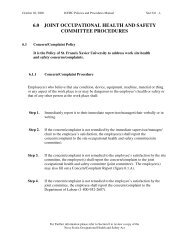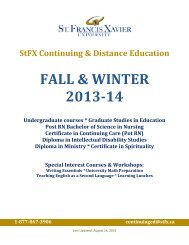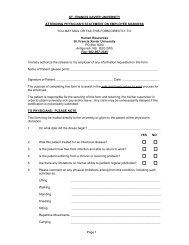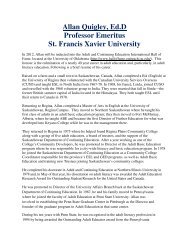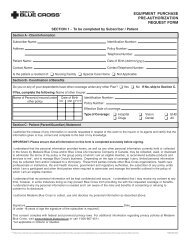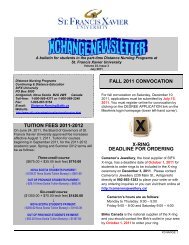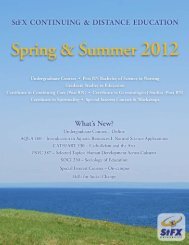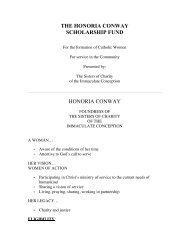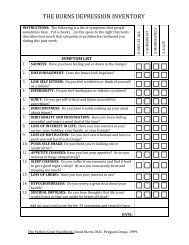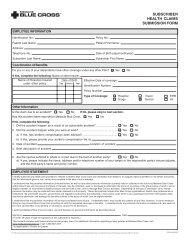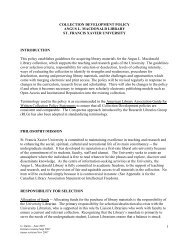StFX Employee Handbook (Non-Union)
StFX Employee Handbook (Non-Union)
StFX Employee Handbook (Non-Union)
- No tags were found...
You also want an ePaper? Increase the reach of your titles
YUMPU automatically turns print PDFs into web optimized ePapers that Google loves.
<strong>Employee</strong> <strong>Handbook</strong>(<strong>Non</strong>-<strong>Union</strong>)January 2012
Table of ContentsINTRODUCTION ............................................................................................. 5Guiding Principles ............................................................................................... 5RECRUITMENT AND SELECTION ...................................................................... 5Equal Opportunity Employment ............................................................................. 5Recruitment and Selection Process ......................................................................... 5Temporary Assignments ........................................................................................ 6Offers of Employment .......................................................................................... 6Nepotism ............................................................................................................ 6ORIENTATION ................................................................................................ 7Purpose .............................................................................................................. 7Scope ................................................................................................................. 7Overview ............................................................................................................ 7Orientation – Department Overview Sessions ......................................................... 7Orientation - University Overview Sessions ............................................................. 8PROBATION ................................................................................................... 8Extension of Probationary Period ........................................................................... 8Time Exclusions ................................................................................................... 8Promotion or Transfer .......................................................................................... 8Probationary Review ............................................................................................. 8Termination ........................................................................................................ 9Resignation ......................................................................................................... 9TERMS AND CONDITIONS OF EMPLOYMENT .................................................. 9<strong>Employee</strong> Status Categories .................................................................................. 9Hours of Work and Breaks ................................................................................... 9Changing Contracted Hours per Week ................................................................ 10Storm Day Policy ............................................................................................... 10Overtime, Stand-by and Call-back ...................................................................... 11Attendance, Lateness, Absenteeism ..................................................................... 12Personal Appearance ......................................................................................... 13Standards of Conduct …………………………………………………………………. 13Security of Property ............................................................................................ 14Discipline and Termination ................................................................................. 14Resignation ....................................................................................................... 14Retirement ........................................................................................................ 14PAYROLL AND BENEFITS ADMINISTRATION .................................................... 14Payroll .............................................................................................................. 14Payroll Information ............................................................................................ 14Benefits ............................................................................................................ 15Pension Plan ..................................................................................................... 15Contributions: ................................................................................................... 15Updated March 2011 - 2 of 31
Retirement Age: ................................................................................................. 15Group Life Insurance ......................................................................................... 16Basic Accident Insurance .................................................................................... 16Optional Group Life .......................................................................................... 16Long-Term Disability Insurance ........................................................................... 16Group Health, Dental and Emergency Travel ....................................................... 17EFAP – <strong>Employee</strong> and Family Assistance Plan ....................................................... 17Accidental Death and Dismemberment Insurance (For <strong>Employee</strong>s and their Dependents)................................................................................................................. 17Optional Critical Illness Insurance (For <strong>Employee</strong>s and their Spouse) ...................... 17Travel Accident Insurance - University Business (Provided by the University) ............ 17LEAVES ......................................................................................................... 18Sick Leave ......................................................................................................... 18What is covered ................................................................................................ 18Entitlement, accumulation, and deduction of sick leave ......................................... 18Notification of Absence by <strong>Employee</strong> ................................................................... 18Medical Documentation ..................................................................................... 18Abuse ............................................................................................................... 19Return to Work .................................................................................................. 19Personal Days ................................................................................................... 19Bereavement Leave ............................................................................................ 19Compassionate Care Leave ................................................................................ 20Leaves of Absence ............................................................................................. 20Jury Duty .......................................................................................................... 20Pregnancy, Parental and Adoptive Leave .............................................................. 21Parental/Adoption Leave .................................................................................... 22Parental and Adoption Leave Allowance .............................................................. 23Paternity Leave .................................................................................................. 24Study Leave ....................................................................................................... 24Vacations .......................................................................................................... 25Holidays ........................................................................................................... 26TUITION CREDITS ......................................................................................... 27Tuition Credit – Children/Spouse ........................................................................ 27<strong>Employee</strong> .......................................................................................................... 27PERFORMANCE MANAGEMENT ..................................................................... 27Promotion and Internal Selection ......................................................................... 27TRAVEL REIMBURSEMENT ............................................................................... 28EMPLOYEE RELATIONS .................................................................................. 28Leadership ........................................................................................................ 28<strong>Employee</strong> Appreciation Day ................................................................................ 28Conflict Resolution ............................................................................................. 28Updated March 2011 - 3 of 31
HUMAN RIGHTS ........................................................................................... 29Bullying and Violence in the Workplace ............................................................... 29Sexual Harassment ............................................................................................ 29OCCUPATIONAL HEALTH AND SAFETY .......................................................... 29FREEDOM OF INFORMATION AND PROTECTION OF PRIVACY (F.O.I.P.O.P.) .. 30What is the purpose of the Act? .......................................................................... 30How are the purposes of the Act achieved? .......................................................... 30<strong>Employee</strong> Obligations ...................................................................................... 311EMPLOYMENT POLICIESAvailable on the <strong>StFX</strong> Human Resources Website.Updated March 2011 - 4 of 31
INTRODUCTIONThis <strong>Handbook</strong> is a working guide for non-unionized employees, supervisors and departmental managersregarding employment-related matters. This <strong>Handbook</strong> covers all non-unionized employees of theUniversity.It is the responsibility of each and every member of management to administer these policies in a fair,consistent and impartial manner.This <strong>Handbook</strong> is a living document, under continual review and subject to periodic amendment by theUniversity. The reader is advised to obtain the most current version from the Human ResourcesDepartment (HR). Throughout this <strong>Handbook</strong>, the feminine includes the masculine, and the plural includesthe singular, and vice versa as the context may require.This <strong>Handbook</strong> is not a definitive or exclusive account of all those matters referred to and is specificallysubject to the express terms of any employment contract, the policies of the University, and to the day-todayauthority and general responsibilities of the Board of Governors and University Administration in themanagement of the University.Guiding PrinciplesThe University is an equal opportunity employer. The University’s relationship with its employees is basedon respect, equity, efficiency and communication. The University does not discriminate in recruiting, hiring,transfers, promotions, compensation, benefits, training, layoffs, recalls from layoffs, or other employmentpractices.It is the University’s intention to provide safe, healthy and harmonious working conditions for its employees.<strong>Employee</strong>s have the right to fairly and reasonably discuss employment-related matters with management.Permanent Part-time and Sessional <strong>Employee</strong>s are eligible for provisions listed in this handbook on aprorated basis, subject to any parameters outlined in individual Benefit or Pension plan texts.RECRUITMENT AND SELECTIONEqual Opportunity EmploymentIt is the policy of the University to provide equal opportunity for all qualified employees and applicants foremployment without regard to age; race; colour; religion; creed; sex; sexual orientation; physical disabilityor mental disability; an irrational fear of contracting an illness or disease; ethnic, national or aboriginalorigin; family status; marital status; source of income; political belief, affiliation or activity; or, anindividual’s association with another individual or class of individuals having such characteristics.For further information contact the Human Resources Department or the University Human Rights andEquity Advisor.Recruitment and Selection ProcessThe University will post all non-union job vacancies internally and/or externally in order to attract the bestqualified candidates. The Human Resources Department will provide assistance and guidance in therecruitment and selection of candidates. The Recruitment and Selection Process may be reviewed on theHuman Resources website: http://www.stfx.ca/administration/hr/policies.htmUpdated March 2011 - 5 of 31
All vacant positions posted for hiring shall be filled by the best qualified candidates selected and appointedon the basis of education, experience, knowledge, abilities, suitability, past performance to be consideredwithin the framework of legislation, applicable collective agreements, equal opportunity, budgetarylimitations and University needs.Temporary AssignmentsWhen an employee is required by management to relieve on temporary assignment in a higher payingposition, and to perform the duties in that position for periods in excess of ten (10) consecutive workingdays, acting pay will be paid to the employee for such relief, provided the employee is capable of carryingon the normal functions in the relief position.Acting pay for relief shall not be less than the salary range applicable for the relief position.For salary, benefit and advancement purposes, the University will recognize time spent by an employee ona temporary assignment if that employee is selected to fill the position on a permanent basis, afteradvertisement and candidate selection.Upon returning to his or her regular duties from an acting assignment, an employee shall receive his or herprevious salary plus any increases and credits toward benefits that he or she would have received but forthe temporary assignment.Offers of EmploymentInitial letters of offer will be issued by the Human Resources Department and signed by the relevantDepartmental manager. Offers of employment will specify the position title, reporting structure, entitlementto insured benefits, vacation entitlement, any specific condition with respect to hours of work, startingsalary, relocation expenses, probationary period, performance review dates and such other terms andconditions as may be specified, including any express variation from the provisions of this <strong>Handbook</strong>.NepotismRelatives of University governors, officers and employees may be employed by the University. No specialadvantage or favouritism will be shown in hiring relatives. A relative of a candidate for employment maynot be involved, directly or indirectly, in assessing the merits, qualifications or capacities of any candidatefor an open position.An employee may not be employed in a position subject to direct or “in-line” supervision or direction by arelative. In circumstances in which an employee is or will be employed in a position which is subject tosuch supervision, the University will consider all options for accommodating the family status of theemployees in question, including but not limited to a transfer at the earliest opportunity of one or the otheremployee to a comparable position not in direct or “in-line” supervision or direction, or a modification ofreporting responsibilities so as to eliminate any direct or “in-line” supervisory role.For purposes of this section, a “relative” includes a parent, spouse (including common law spouse, child,sibling or half-sibling, grandparent, grandchild, niece, nephew or any of those by way of marriage (“inlaw”or “step” relatives).Updated March 2011 - 6 of 31
ORIENTATIONPurposeThe primary purpose of a comprehensive orientation program is to make the transition to Universityemployment a smooth and positive one and to ensure that the new employee is fully informed abouther/his new job and workplace. An orientation program also serves as a means of ensuring a goodemployee-organization “fit” for the longer term. The program requires a coordinated effort between theHuman Resources Department (providing the University level orientation) and the individual academic orservice departments (providing departmental and job-specific orientation).A University-wide orientation program for new employees is intended to:Scope1. Reduce anxiety - by familiarizing new employees with the University, its goals, mandate andphilosophy, and the expectations for particular positions.2. Reduce demands on supervisors and co-workers - by advancing the knowledge of the newemployee to meet the challenges of the new job, without undue reliance on others in theimmediate workplace.3. Develop realistic job expectations – by instilling positive attitudes and facilitating awareness ofUniversity-wide employment expectations.This program applies to new non-union employees of the University with contracts of twelve (12) months ormore in duration.Student employees are not governed by this Orientation program, however, departments and faculties arerequired to conduct appropriate job and work site orientations with new student employees. The orientationactivities will be determined by the department based on the particular requirements of the work involvedand other factors relevant to the student’s employment. As a minimum, however, these orientationactivities shall include an overview of the student’s responsibilities, and relevant departmental policies andprocedures, and policies and procedures pertaining to workplace health and safety.OverviewOrientation at the University will occur in two phases in order to enable new employees to receive both amacro and a micro view of the institution and the new position.The Department Orientation will be conducted at the departmental level at the time the new employeecommences his/her employment with the University, or at the time an employee is seconded or temporarilyassigned to the department from elsewhere in the University for a period of greater than six (6) months.The University Overview Orientation sessions will be held in one-on-one sessions with new employees.The orientation sessions will be facilitated by the Human Resources Department.Orientation – Department Overview SessionsProvided at the departmental level, this component of the New <strong>Employee</strong> Orientation Program will helpemployees understand the job-specific and department-specific expectations. This orientation should beconducted and/or coordinated by the manager of the Department.The Department Overview will be conducted in accordance with the Department Orientation for New<strong>Employee</strong>s - Guidelines for Supervisors.Updated March 2011 - 7 of 31
A new employee will receive, during his or her first week, a University orientation package and a New<strong>Employee</strong> Orientation Checklist.Subject to the employee’s consent, a photograph of a new employee will be posted on the “New<strong>Employee</strong>s” section of the HR website.The Department Orientation Checklist for New <strong>Employee</strong>s is to be completed and signed by the newemployee to signify that all the activities have been completed or provided. The form shall be returnedto the HR Department within one week of the new employee’s start date.Orientation - University Overview SessionsThe University Overview is a general session conducted by an HR representative and generally held ina one-on-one format, to orient new employees to the University workplace, and the broader goals ofthe University. A University Overview will usually take place within the first week of employment.PROBATIONNew permanent employees must serve a probationary period of six (6) months, unless waived in writing inthe initial letter of offer. During the probationary period:a) the employee’s manager or supervisor shall review with the employee the job description andperformance expectations as well as provide appropriate guidance and leadership;b) the employee shall demonstrate skills, abilities, quality of work, and commitment to theposition, including appropriate conduct toward co-workers, students, other persons and theUniversity.<strong>Employee</strong>s hired for a term of less than one (1) year shall serve a probationary period less than six (6)months. A probationary <strong>Employee</strong> serves a trial period to determine competence and suitability for aparticular position and may be terminated if, in the Manager’s judgment, she does not meet reasonablestandards for the position.Extension of Probationary PeriodThe probationary period may be extended for up to the length of the original probationary period.Clearly defined, written objectives shall be set with the employee for the extension period, to resolve anyremaining performance issues.Time ExclusionsThe probationary period does not include time the employee may have spent as a temporary employee.Promotion or TransferIf an employee is promoted or transferred to a new position, an appropriate probationary period may berequired.Probationary ReviewAn informal performance review may be held at the half-way point of the probationary period. A formalperformance review must be conducted near the end of the probationary period, and a review formcompleted, signed and forwarded to Human Resources. The probationary review form shall be included inthe employee’s HR file. The probationary review form can be found on the HR website.Updated March 2011 - 8 of 31
TerminationIf at any time, a probationary employee’s supervisor determines that the employee has failed to perform atthe level required for a permanent appointment to the position, notice in writing of the deficiencies will begiven to the employee. The employee shall, within the remainder of the probationary period or suchextension as may be granted by the University in its discretion, have an opportunity to improve his or herperformance prior to any decision to terminate.If a probationary employee does not reach the desired level of performance or fails to fulfil any othercondition of employment, or for any other reason it is determined that the employee’s employment is to beterminated, his or her employment may be terminated at any time during the probationary period,following consultation with the Human Resources Department.Notice in writing of not less than one week, or pay in lieu, will be given, other than in circumstances of justcause for summary dismissal.ResignationProbationary employees are required to provide at least one week’s notice of resignation, in writing.TERMS AND CONDITIONS OF EMPLOYMENT<strong>Employee</strong> Status CategoriesFollowing are the definitions for the various employee status categories:Regular Full-Time: at least 32.5 hrs per week in an established position and on a continuing basis.Regular Part-Time: Works less than 32.5 hrs per week, in an established position and on acontinuing basis.Sessional On-going: Works during the academic year only, with unpaid breaks each summerShort Term or Temporary Contract: Works in a position established for a specific period of time orfor the duration of a specific project or group of assignments.Casual: Works on an on-call basis and generally has the option to work or not when called.Hours of Work and BreaksThe work week for Regular Full-Time positions shall be 37.5 hours per week.Managers and supervisors, given the nature of their positions, work such hours as are necessary to fulfiltheir obligations and responsibilities. Because of the flexibility and additional demands of these positionsno standardized work week/day is set for them. However, thirty-seven and one half (37.5) hours serves as aguide for the average work week, taking into consideration the departmental area of employment. Sincethese positions require flexibility in the work week/day, this flexibility may be applied to time off whereextraordinary hours have been worked and the immediate manager is in agreement.Individual work schedules will vary depending on departmental requirements and must be approved by theimmediate supervisor.Individual departments and divisions may adopt a flex-time system, as follows:Updated March 2011 - 9 of 31
a) In any one (1) day, the day shall be broken into two (2) parts: core periods and flexible periods.i) Core Period- 10:00 a.m. to 12:00 noon and- 1:00 p.m. to 3:00 p.m.ii) Flexible Period- 8:00 a.m. to 10:00 a.m.- 12:00 noon to 1:00 p.m. and- 3:00 p.m. to 5:30 p.m.b) Generally, an employee is required to:i) attend at work during the core periods five (5) days a week;ii) work not less than the full hours per week as defined for their position (normally ranging from32.5-37.5 hrs/wk);iii) make up the balance of the hours required per week during the flexible periods if needed.Where a flex-time system is adopted, managers or supervisors may nevertheless agree to individualarrangements with regards to hours of work and break times of employees.<strong>Employee</strong>s are entitled to two (2) fifteen (15) minute paid breaks if they work more than five (5) hours perday. They are entitled to one (1) fifteen (15) minute paid break if they work more than three (3) hours andless than five (5) hours per day.Unpaid meal breaks can be for one-half (1/2) hour to one (1) hour per day.Changing Contracted Hours per WeekA change in an employee’s number of contracted hours per week may be initiated by either HR, theemployee, or the department manager or supervisor. Upon approval by HR and the departmentmanager or supervisor, a confirmation letter will be issued. The letter will be signed by the manager orsupervisor and also by the employee to indicate acknowledgment of the change in terms ofemployment and then submitted to Human Resources for action.Storm Day Policy<strong>Employee</strong>s are expected to report for work during inclement weather if it is safe for them to do so.Should an employee not be able to report to work because of weather, he/she must makearrangements with his/her supervisor choosing one of the following options:Make up the time within two weeks as mutually agreed or;Use accumulated overtime or;Use a vacation dayPlease also see Policy – Unscheduled Closure and/or Cancellation of Classes PolicyThe status of University operations during a storm or emergency will normally be communicated onCJFX (XFM) Radio, campus e-mail and/or voicemail systems.Updated March 2011 - 10 of 31
Overtime, Stand-by and Call-backOvertime work must be requested and authorized by an employee’s immediate supervisor prior tocommencement of such work.Overtime shall be related to special projects and kept to a minimum and should not form aregular part of an employee’s work schedule.Overtime, when necessary, shall be distributed fairly amongst those employees regularlyperforming the work.Upon request from the department manager, employees may be required to work overtime. Thedepartment manager must take into consideration any prior personal commitments that theemployee may have made.Work within one hour of an employee’s regular quitting time is not considered overtime. If anemployee is requested to work more than one hour, then the overtime will be considered to havestarted at his or her normal quitting time.Overtime is calculated on a weekly basis - not daily.<strong>Employee</strong>s may not accumulate such lieu time in excess of 40 hours without written approval fromHR, and must take accumulated hours at a time approved by the department manager. Such timemust be taken within three (3) months of being accumulated unless approved in writing by theDepartment Manager. There will be no pay out of accumulated hours if not taken within the timelimit specified.All management is exempt from the above overtime regulations.Taking into account operational requirements, the Manager will grant compensation for overtimehours worked in equivalent time off at the applicable rate. If a mutually-agreed time cannot bedetermined within ten (10) working days of the overtime worked, pay will then be approved.An <strong>Employee</strong> who is required to work overtime 1 (one) full hour beyond the <strong>Employee</strong>’s normal dailyhours of work shall be compensated at the rate of time and one half (1 ½) the normal hourly rate ofpay for all such overtime work. Overtime compensation shall be based on the rate of pay in effect atthe time the overtime is worked. <strong>Employee</strong>s shall be paid two times (2 x) his/her normal hourly rate ofpay for all overtime worked on an <strong>Employee</strong>’s subsequent day of rest.An <strong>Employee</strong>, who is required to work a minimum of three (3) hours' overtime following her scheduledhours of work and where it is not practical for her to enjoy her usual meal break before commencingsuch work, shall be granted thirty (30) minutes with pay as a meal period and shall be provided with aten (10) dollar meal allowance. When overtime work prevents the taking of the meal break, the<strong>Employee</strong> shall be credited with thirty (30) minutes of pay at the overtime rate and provided with ameal provided with a ten (10) dollar meal allowance.The University will not require an <strong>Employee</strong> to work an unreasonable amount of overtime againsthis/her wishes.Stand-By(a)<strong>Employee</strong>s who are required by the Employer to stand-by shall receive stand-by pay inthe amount of twelve dollars ($12.00) for each stand-by period of eight (8) hours orless. Stand-by pay shall apply where an <strong>Employee</strong> is assigned to carry a cell phone orother electronic messaging device or be available at a known telephone number for astand-by period assigned by a Manager or Supervisor.Updated March 2011 - 11 of 31
(b)No compensation shall be granted for the total period of stand-by if the <strong>Employee</strong> isunable to report for duty when required.Call Back(a)(b)When an <strong>Employee</strong> is called back and reports for work after leaving their place of workfor the day, and such recall has not been scheduled prior to leaving work, the<strong>Employee</strong> shall be compensated a minimum of four (4) hours pay at his/her straighttime rate for the period worked or the applicable overtime for the hours worked,whichever is greater.When an <strong>Employee</strong> is called at home by the Employer, outside their scheduled workinghours, and is required to perform a service for the University from home, they will bepaid at the applicable overtime rate for the hours required to perform the work, for aminimum of thirty (30) minutes at the applicable overtime rate.<strong>Employee</strong>s may occasionally be requested to work when the University is closed. All <strong>Employee</strong>srequired to work on days when the University is closed will be compensated at the rate of time andone-half (1 ½) the normal hourly rate for all hours worked.All management is exempt from the above Stand-By and Call Back regulations.Attendance, Lateness, AbsenteeismAll employees are responsible to:a) Be at work on time unless for reasonable and unavoidable causes;b) Notify his or her supervisor as far in advance as possible of any intended absence from workand to provide such reasonable medical documentation as is required to support the absenceand/or fitness to return to work.d) Attend to personal affairs and obligations outside of working hours.Significant AbsenteeismIt is the responsibility of supervisors to monitor absence rates. Supervisors must bring to theattention of the HR Department any employee whose absenteeism rate is significantly higher thanthe norm, including any employee who is absent for any reason for a total of 30 days or more, notnecessarily consecutive, in any 12 month period, or who is absent for any reason at a frequency often (10) or more times in any 12 month period.Upon notice of an employee’s significant absenteeism, the Human Resources Department shalldetermine the appropriate means of ensuring that the employee returns to a more satisfactoryattendance rate. In consultation with the employee and his or her manager or supervisor, HR shalldetermine the cause(s) of the employee’s absenteeism, and, as appropriate to the circumstances:inquire whether the University can provide assistance (e.g., counselling or otheraccommodation);counsel the employee with regard to the University’s attendance expectations;inform the employee that he or she is required to take all reasonable measures toimprove his or her attendance, that his or her attendance will continue to be monitoredand that a review will be conducted at a future specified date;inform the employee that in the absence of improvement his or her employment may beterminated.Updated March 2011 - 12 of 31
LatenessThe employee will be provided with a letter confirming the points discussed, as set out above.The employee’s supervisor or manager, in consultation with HR, will continue to monitor theemployee’s attendance for so long as is deemed necessary to confirm that the employee’sattendance rate has returned to a satisfactory level.In the event that the employee’s attendance record continues to be unsatisfactory, further action,including as appropriate discipline and possible termination in accordance with the University’sDiscipline and Termination Policy, will be taken by the employee’s supervisor or manager inconsultation with HR.Unexcused lateness compromises the performance of the employee and the operations of the University,and is cause for discipline. It is the responsibility of supervisors and managers to monitor lateness and todetermine whether there is a reasonable excuse. Human Resources will be notified regarding anyemployee who has developed a pattern of unexcused lateness.Excusable lateness or absenteeismOccasional lateness or absenteeism may be excused if caused or necessitated by illness or by anunforeseeable domestic contingency, or by some unforeseeable emergency that affects the employeeand/or his or her immediate family, and other similar occurrences beyond the reasonable control orforeseeability of the employee.Deduction of pay for unexcused lateness or absenceDiscipline for unexcused lateness or unauthorized absence includes but is not limited to deduction of pay,in addition to any other disciplinary action which may be warranted.SicknessSee guidelines for Sick Leave under the Leaves section of this handbook.Personal Appearance<strong>Employee</strong>s are expected to be respectful of the values and standards of all members of the Universitycommunity. <strong>Employee</strong>s are expected to dress in a manner consistent with the nature of their positions andto observe good habits of grooming and personal hygiene at all times.An employee who is inappropriately dressed, or whose personal appearance or behaviour is unsuitable forthat employee’s position may be sent home, and will be required to return to work in an acceptable stateof appearance. This time away will be considered personal time off.Standards of Conduct:All employees are required to preserve and enhance the University’s image and reputation of integrity,credibility and honesty. The Standards of Conduct and Conflicts of Interest Policy (HR Policy #101) isattached as an Appendix and also available on the HR Department website.http://www.stfx.ca/administration/hr/policies.htmUpdated March 2011 - 13 of 31
Security of PropertyAll University property (including supplies, materials, equipment, vehicles, buildings, etc.) has beenobtained because it has been deemed to be necessary to meet the objectives of the University. Private useof University property may impede operational objectives of University. Not all employees have equalaccess to University property and as a consequence any private use may be seen as an unfair benefit.Therefore, private use of University property will be permitted only with written approval. If the property issurplus to the needs of the University, Procurement Services may dispose of it by sale or auction.Discipline and TerminationThe University’s Discipline and Termination Policy (HR Policy #102) is attached as an Appendix and alsoavailable on-line, at:http://www.stfx.ca/administration/hr/policies.htmResignationExcept as otherwise specified in the employee’s contract of employment, the University requires a minimumof two (2) week’s notice of resignation in writing to the immediate supervisor.Resignation notice periods normally are expected to exclude any unused vacation entitlement. All keys andother University property must be returned in order to obtain payroll clearance.RetirementThe normal retirement age for employees is at age 65.PAYROLL AND BENEFITS ADMINISTRATIONPayrollPayroll is processed bi-weekly. Pay day is every second Friday and is automatically deposited in theemployee’s bank account. A statement of this deposit is forwarded to the employee through campus mail.Without exception, deadline for payroll submissions is 4:30 pm on Tuesday the week before the applicablepay date. Proper documentation is required from managers and supervisors in order to ensure anaccurate, timely payroll. A “Payroll Request” form is to be used when submitting additions/deletions oradjustments to employee personal information and/or payroll. All information requested on this form mustbe completed in full. The form can be downloaded here:http://www.stfx.ca/administration/hr/payroll.htmPayroll InformationInformation collected and used for payroll purposes includes name, address, telephone, marital status,dependent data, tax status, S.I.N., etc. and such other information as may be required for employmentpurposes. Personal information about employees will also be collected and used for the administration ofthe University’s programs, in accordance with the Freedom of Information and Protection of Privacysection, below.Updated March 2011 - 14 of 31
Personal information about employees will be collected, and retained in the Human Resources Departmentand elsewhere as necessary. All personal employee information will be safeguarded and not used orreleased to anyone without the consent of the employee, except in accordance with the purposes for whichit is collected or as required by law.Upon hiring, Human Resources will obtain, and safeguard pertinent data from each person.Human Resources will be responsible for entering and maintaining such data in the Payroll/HRISsystem.Access to an employee’s personal information will be granted to the employee, upon request.When authorized by an employee, confirmation of employment/earnings, and other inquiries willbe handled by Human Resources, and will consist of verification of necessary details only.<strong>Employee</strong> personal information must be kept up to date. Human Resources must be advised of anychanges such as employment data changes, benefits, insurance, beneficiary, bank accounts, etc.BenefitsDisclaimer:The following sub-sections pertaining to Benefits are informal summariesof the University’s group benefit programs. They are not insurancepolicies, and do not grant or confer any contractual rights. All rights underthese programs shall be governed by the provisions of the Master Policy,Administrative Services Agreement and Plan Documents and by applicablelaw.Pension PlanEligibility:All details can be accessed on the HR website at:http://www.stfx.ca/administration/hr/staffbenefits.htmi) Any employee in possession of a probationary permanent appointment at the University shallbecome a member of the plan at the date of hire.ii) Any member on a fixed term contract basis shall be enrolled after twenty-four months ofcontinuous service.Contributions:Each Member contributes 5% of salary and the University contributes an additional 8%. A Membermay make voluntary additional contributions up to the maximum allowed by the Income Tax Act.Retirement Age:The "Normal Retirement Date" for non-unionized employees shall be the first day of the month coincidentwith or next following their sixty-fifth (65th) birthday. <strong>Employee</strong>s may retire preceding their NormalRetirement Date provided they have attained their fifty-fifth (55th) birthday.Updated March 2011 - 15 of 31
Group Life InsuranceEligibility: All regular employees with a minimum of 20 hours per week, Executive Contract <strong>Employee</strong>sand Contract <strong>Employee</strong>s with a two or more year contract must participate in the Group Life InsurancePlan as a condition of employment if they commenced employment after June 1, 1978.Amount of Insurance: Amount of insurance is based on age and salary as at September 1st each year.Termination: Insurance shall automatically cease at age 70 or retirement whichever is earlier. Insuranceshall terminate thirty-one (31) days after the day of termination of employment, or immediately upontermination of the master contract between the Insurer and the University.One-half of the premium for the benefit is paid by the University.Basic Accident InsuranceEligibility: This insurance takes effect on the same date the Group Life Insurance takes effect. Thisinsurance is the equivalent of a double indemnity feature under a group life program.Amount of Insurance: The amount of principal sum applicable is equal to the amount of Group LifeInsurance referred to above.Termination: The insurance with respect to an insured person shall terminate on the same date that his/herGroup Life Insurance with the University terminates.Half the premium for the benefit is paid by the UniversityOptional Group LifeEligibility: Participant of Group Life Insurance Plan (see above).Amount of Insurance: Amount of optional insurance is a choice of either one (1) or two (2) or three (3)times annual salary.Evidence of Insurability Requirements: Applicants are required to submit satisfactory evidence ofinsurability.Termination: Optional Group may be terminated on at least thirty (30) days' notice or at age sixty-five(65).Long-Term Disability InsuranceEligibility: All regular employees with a minimum of 20 hours per week, Executive Contract<strong>Employee</strong>s must participate. Contract <strong>Employee</strong>s with a two or more year contract will be enrolledafter the completion of 24 months of continuous service.Termination: Your coverage terminates under the following circumstances:When you are no longer in an eligible class either by virtue of being transferred to an ineligibleclass or by termination of active full-time employment;When the Policy providing the coverage terminates;When you are on a leave of absence without pay;When you reach age 65.Updated March 2011 - 16 of 31
Fifteen Week Waiting Period: The University will assume responsibility for the employee's salary, minusany statutory or comparable plans or benefits, regardless of when received, during the fifteen (15)week waiting period for benefits, provided the employee has accrued this many sick days.Group Health, Dental and Emergency TravelEligibility: All eligible regular employees with a minimum of 20 hours per week, Executive Contract<strong>Employee</strong>s and Contract <strong>Employee</strong>s with a two or more year contract must participate in the GroupHealth, Dental and Emergency Travel Insurance Plan as a condition of employment.Termination: Coverage will cease at the earlier of retirement, termination of employment or on August 31 stfollowing the employee’s 68 th birthday.EFAP – <strong>Employee</strong> and Family Assistance PlanThe University offers an employee and family assistance program, delivered by Shepell-Fgi for all Universityemployees. The program provides confidential access to professional short-term counseling, onlinecourses and information such as an online database of childcare/eldercare resources in the community.More information can be accessed on the HR website at:http://www.stfx.ca/administration/hr/staffbenefits.htmAccidental Death and Dismemberment Insurance (For <strong>Employee</strong>s and their Dependents)a) Eligibility: On a voluntary basis qualified regular full-time employees may participate in this planprovided that they have not attained age sixty-five (65).b) Coverage: As per the terms of the policy of insurance.c) Termination: The insurance automatically terminates as of the end of the month following termination ofemployment, retirement, or attainment of age sixty-five (65). Dependent coverage terminates on thesame date that the employee’s coverage ceases.Optional Critical Illness Insurance (For <strong>Employee</strong>s and their Spouse)Eligibility: All permanent, active, full-time (minimum 20 hours per week), Executive Contract <strong>Employee</strong>sand contract <strong>Employee</strong>s with a two or more year contract and their spouses under the age of 65 at time ofapplication are eligible to participate.Optional Critical Care insurance provides a "Living Benefit" that is intended to provide you and / or yourspouse with a Lump Sum payment if you are diagnosed with one of the covered illnesses or medicalconditions.More information can be accessed on the HR website at:http://www.stfx.ca/administration/hr/staffbenefits.htmTravel Accident Insurance - University Business (Provided by the University)Eligibility: All regular full-time employees participate in this plan provided they have not obtained the ageofseventy (70).Coverage: Accidental Death, Dismemberment or Loss of Sight up to the principal sum of $250,000 whileon University business away from the premises of the University where they are permanently assigned, perUpdated March 2011 - 17 of 31
the terms of the policy of insuranceTermination: Coverage will cease on termination of employment or immediately upon termination of themaster contract between the Insurer and the University.LEAVESSick LeaveThe University’s sick leave policy is intended to compensate employees for loss of earnings due to inability toattend University employment because of injury or illness.What is coveredSick leave covers absence due to illness or injury. Sick leave also includes scheduled professionalexamination and treatment by a qualified physician or specialist.Entitlement, accumulation, and deduction of sick leavePaid sick leave is available to employees with contracts of 12 months or longer. <strong>Employee</strong>s with contracts ofless than twelve months are not entitled to paid sick leave, but in all other respects are subject to this policy,including with regard to providing medical certificates and other information for absence due to illness orinjury, as provided below.For qualifying employees, after six (6) months of continuous service, nine (9) days sick leave shall becredited to the employee and will accrue thereafter at the rate of one and one-half (1 1/2 ) days for everyfull month an employee is employed, up to a maximum of seventy-five (75) working days. Sick leave time isearned for time worked and / or paid; it does not accrue while the employee is not actively being paid (e.g.,for sessional employees, over the summer).Eligible absences shall be deducted from accumulated sick leave time by full or half-days lost.Notification of Absence by <strong>Employee</strong>An employee who is or who will be off on sick leave must notify his or her supervisor or department, as soonas the employee is aware that such absence will be required. <strong>Employee</strong>s must indicate the expectedduration of the absence, if known. Any change in the information provided must be communicated to thesupervisor as soon as the employee is aware of the change.The employee must provide the University with updated information from time to time, upon request.Medical DocumentationThe University may require the employee to provide a medical statement from a qualified physician. TheUniversity’s Attending Physician’s Statement on <strong>Employee</strong> Sickness Form may be required for any sick leave,regardless of the duration.For sick leave longer than 4 consecutive days, and/or for more than 8 non-consecutive days within a year,employees must provide a doctor’s note. HR must be given such notes for lengthy absences by the Manageror Supervisor. If for any reason an employee wishes to give the sick note directly to Human Resources, theymay do so but it is still the employee’s responsibility to contact the Manager or Supervisor to advise him orher of the absence.The University may, in its discretion, require the employee to provide further medical information from aqualified physician or specialist, including diagnosis of a medically-recognized condition and/or aUpdated March 2011 - 18 of 31
Abuseprescribed treatment plan. The employee is required to adhere to the prescribed treatment plan and toprovide the University with reasonable evidence of compliance, upon request.The University reserves the right to require an independent medical examination by a physician of theUniversity’s choosing, at the University’s cost.Where the University has reason to believe that an employee is abusing sick leave, in addition to all otherpowers of the University, the University may investigate the suspected abuse using all reasonable means,and/or issue to the employee a standing directive that requires the employee to submit a medical certificatein a form satisfactory to the University for any subsequent period of absence for which sick leave is claimed.Return to WorkPrior to an employee’s return to work from medically-related absence, the University may require theemployee to provide a medical certificate from a qualified physician or specialist, confirming the employee’sability to return to work and describing any continuing job-related symptoms or limitations on theemployee’s fitness to perform his or her job responsibilities. The University may require a sufficient reviewperiod in order to assess any workplace accommodations which may be required.The University may require further medical information prior to permitting the employee to return to work.The University may require follow up medical information after the employee has returned, as to anycontinuing job-related symptoms or conditions.Personal DaysThe University recognizes that with the stress of modern life and the change in workforce demographicscome the added responsibilities for family concerns that may need to be addressed during the regular workweek. In this regard, the University provides up to five (5) days per vacation year per employee to attend topersonal matters. These days are intended to cover time needed for personal matters such as looking aftersick children, elderly parents, disabled family members or other events of a serious nature that wouldnormally require unpaid time off. These days do not accumulate and do not roll forward from one year tothe next.A pro-rated number of personal days apply to new hires, sessional employees, short-term contractsand part time employees. <strong>Employee</strong>s will not be required to provide specific reasons for the paid leave,but are required to inform their Manager or Supervisor as soon as they are aware that they will requiretime off.Absences shall be deducted from Personal Days time by full or half-days lost.Bereavement LeaveIn the event of the death of a spouse (including common-law spouse resident with the employee), child(including child of common-law spouse), father, mother, brother, sister, step-child, mother-in-law, fatherin-law,son-in-law, daughter-in-law, or any family member living in domicile, the employee shall be entitledto leave with pay for up to seven (7) consecutive calendar days that must include the day of the funeral.During such period, the employee shall be paid for those days which are not the employee's normal daysof rest.In the event of the death of a grandparent, grandchild, sister-in-law, brother-in-law, uncle, aunt, firstcousin, nephew, niece, the employee shall be entitled to leave with pay for up to one (1) day for thepurpose of attending the funeral.Updated March 2011 - 19 of 31
If an employee is on vacation leave at the time of bereavement, the employee shall be granted appropriatecompassionate leave and be credited the appropriate number of days of vacation leave.Compassionate Care LeaveCompassionate care leave is an unpaid, maximum eight-week leave for an employee whose personalcare is required for a seriously ill family member, including a spouse (including common-law spouseresident with the employee), child (including child of common-law spouse), father, mother, brother,sister, step-child, mother-in-law, father-in-law, son-in-law, daughter-in-law, or any family memberliving in domicile, who has a high risk of dying within 26 weeks. An employee must have beenemployed by the University for more than three months before becoming eligible for compassionatecare leave.A request for compassionate care leave must be made to the University in writing, as far in advance aspossible. Failure to make such a request may result in permission being denied, or the requested startdate being delayed. An employee requesting compassionate care leave may be required to provide amedical certificate from a qualified practitioner, stating that the employee’s family member is seriouslyill and requires personal care.The leave may be broken up into separate periods of one-week blocks, depending on the needs of theUniversity.Note: <strong>Employee</strong>s who take all compassionate care leave at once may qualify for a six-weekcompassionate care leave benefit under the federal government’s Employment Insuranceprogram. Details may be found at:http://www.hrsdc.gc.ca/en/ei/types/compassionate_care.shtml#WhoLeaves of AbsenceSubject to the needs of the University and in the sole discretion of the University, an employee may begranted a non-paid leave of absence upon the approval of his or her manager or supervisor, inconsultation with Human Resources, for a period of up to one year. During the period of leave theemployee’s position will be held open until he or she returns. These leaves cannot be requested when theemployee is offered a permanent position within another area of the University.Insured benefits, excluding Long Term Disability, may be continued for up to one year of the approvedleave, subject to the Member paying the full cost, and meeting any qualifying conditions under specificplans.Jury Duty<strong>Employee</strong>s required to serve on jury duty and/or appear as a witness under subpoena in a criminalproceeding shall not be financially prejudiced as a result of carrying out such duties. The University shallreimburse the employee for any negative difference between any remuneration or reimbursement providedwith regard to such duties and the employee’s normal wages.<strong>Employee</strong>s who are required to appear as witnesses in a civil or administrative matter by subpoena orsimilar summons shall be entitled to an unpaid leave of absence.Updated March 2011 - 20 of 31
Pregnancy, Parental and Adoptive Leave(a)The University will not terminate the employment of an <strong>Employee</strong> because of herpregnancy.(b) A pregnant <strong>Employee</strong>, who has been employed with the University for at least one (1)year, is entitled to an unpaid leave of absence of up to seventeen (17) weeks.(c)(d)(e)(f)(g)(h)(i)(j)(k)(l)The University may, prior to approving such leave, request a certificate from a legallyqualified medical practitioner stating that the <strong>Employee</strong> is pregnant and specifying theexpected date of delivery.Pregnancy leave shall begin on such date as the <strong>Employee</strong> determines, but not soonerthan sixteen (16) weeks preceding the expected date of delivery, and not later than thedate of delivery.Pregnancy leave shall end on such date as the <strong>Employee</strong> determines, but not soonerthan one (1) week after the date of delivery, and not later than seventeen (17) weeksafter the pregnancy leave began.A pregnant <strong>Employee</strong> shall provide the Employer with at least four (4) weeks notice ofthe date she will begin her pregnancy leave. Such notice may be amended by the<strong>Employee</strong> provided that the <strong>Employee</strong> provides at least four (4) weeks notice of thechange.An <strong>Employee</strong> shall not provide the Employer with less than four (4) weeks’ notice of thedate the <strong>Employee</strong> will return to work on completion of the pregnancy leave. Suchnotice may be amended by the <strong>Employee</strong> provided that the <strong>Employee</strong> provides at leastfour (4) weeks’ notice of the change.Where notice as required under (f) or (g) above is not possible due to circumstancesbeyond the control of the <strong>Employee</strong>, the <strong>Employee</strong> shall provide the Employer as muchnotice as reasonably practicable of the commencement of her leave or her return towork.Where an <strong>Employee</strong> reports for work upon the expiration of the period referred to in (e)above, the <strong>Employee</strong> shall resume work in the same position she held prior to thecommencement of the pregnancy leave, with no loss of service or benefits accrued tothe commencement of the pregnancy leave.While an <strong>Employee</strong> is on pregnancy leave, the Employer shall maintain coverage formedical, extended health, group life and any other <strong>Employee</strong> benefit plans and shallcontinue to pay its share of premium costs for maintaining such coverage during theperiod of pregnancy leave.While on pregnancy leave, an <strong>Employee</strong> shall continue to accrue and accumulateservice and service credits for the duration of her leave, and her service shall bedeemed to be continuous. Regular vacation and paid sick leave is accrued duringpregnancy leave and during the top-up period of parental leave.Leave for illness of an <strong>Employee</strong> arising out of or associated with the <strong>Employee</strong>’spregnancy prior to the commencement of, or the ending of, pregnancy leave grantedUpdated March 2011 - 21 of 31
in accordance with (b) above, may be granted sick leave in accordance with the SickLeave provisions in this <strong>Handbook</strong>(m)Pregnancy/Birth Leave Allowance(i)(ii)An <strong>Employee</strong> entitled to pregnancy leave, who provides the Employer withproof that she has applied for, and is eligible to receive employment insurance(E.I.) benefits pursuant to the Employment Insurance Act and Regulations, shallbe paid an allowance in accordance with the Supplementary EmploymentBenefit (S.E.B.).In respect to the period of pregnancy leave, payments made according to theS.E.B. Plan will consist of the following:(1) Where the <strong>Employee</strong> is subject to a waiting period of two (2) weeksbefore receiving E. I. benefits, payments equivalent to ninety-five percent (95%) of her weekly rate of pay for each week of the two (2) weekwaiting period;(2) Up to a maximum of fifteen (15) additional weeks, the <strong>Employee</strong> shallreceive an amount equal to the difference between the E.I. benefitsreceived and ninety-five per cent (95%) of the <strong>Employee</strong>’s normalsalary.(iii)(iv)Where an <strong>Employee</strong> becomes eligible for a salary increment or pay increaseduring the benefit period, benefits under the S.E.B. plan will be adjustedaccordingly.The Employer will not reimburse the <strong>Employee</strong> for any amount she is requiredto remit to Human Resources Development Canada.Parental/Adoption Leave(a)(b)(c)(d)The maximum combined pregnancy leave and parental leave to which an <strong>Employee</strong> isentitled is fifty-two (52) weeks.An <strong>Employee</strong> who has been employed with the Employer for at least one (1) year, andwho becomes a parent for one or more children through the birth of the child orchildren or placement of a child or children within the home through an adoptionprocess is entitled to an unpaid leave of absence of up to fifty-two (52) weeks.Where an <strong>Employee</strong> takes pregnancy leave (as described above), and the <strong>Employee</strong>’snew born child or children arrive in the <strong>Employee</strong>’s home during pregnancy leave,parental leave begins immediately upon completion of the pregnancy leave andwithout the <strong>Employee</strong> returning to work and ends not later than thirty-five (35) weeksafter the parental leave began.Where an <strong>Employee</strong> did not take pregnancy leave, parental leave begins on such dateas determined by the <strong>Employee</strong>, coinciding with or after the birth of the child orchildren first arriving in the <strong>Employee</strong>’s home, and ends not later than fifty-two (52)weeks after the child or children first arrive in the <strong>Employee</strong>’s home.Updated March 2011 - 22 of 31
(e)(f)(g)(h)(i)(j)(k)(l)Notwithstanding (c) or (d) above, where an <strong>Employee</strong> has begun parental leave, andthe child to whom the parental leave relates is hospitalized for a period exceeding, orlikely to exceed one (1) week, the <strong>Employee</strong> is entitled to return to and resume work inthe position held immediately before the leave began. The <strong>Employee</strong> is entitled to onlyone (1) interruption and deferral of each parental leave.The <strong>Employee</strong> shall give the Employer at least four (4) weeks notice of the date the<strong>Employee</strong> will begin parental leave.The <strong>Employee</strong> shall give the Employer at least four (4) weeks notice of the date the<strong>Employee</strong> will return to work upon completion of the parental leave.Where an <strong>Employee</strong> reports for work upon the expiration of the period referred to in (b)above, the <strong>Employee</strong> shall resume work in the same position she held prior to thecommencement of the parental leave.While on parental leave, an <strong>Employee</strong> shall continue to accrue and accumulate servicefor the duration of her leave, and her service shall be deemed to be continuous.Regular vacation leave is accrued during parental leave paid top-up period.While an <strong>Employee</strong> is on parental leave during the ten (10) week top-up period, theEmployer shall maintain coverage for medical, extended health, group life and anyother <strong>Employee</strong> benefit plans and shall continue to pay its share of premium costs formaintaining such coverage during the period of parental leave.The Employer shall notify the <strong>Employee</strong> of the option and the date beyond which theoption referred to in (j) above may no longer be exercised at least fourteen (14)calendar days prior to the last day on which the option could be exercised to avoid aninterruption of benefits.Where the <strong>Employee</strong> opts in writing to maintain the benefit plans referred to in (j)above, and where applicable, the <strong>Employee</strong> shall enter into an arrangement with theEmployer to pay the cost required to maintain the benefit plans, including theEmployer’s share thereof, and the Employer shall process the documentation andpayments as arranged.Parental and Adoption Leave Allowance(a)(b)(c)<strong>Employee</strong>s who take pregnancy leave and continue on to take parental leave will beeligible to receive an amount equal to the difference between the E.I. benefits receivedand ninety-five per cent (95%) of the <strong>Employee</strong>’s normal salary to a maximum of ten(10) additional weeks.An <strong>Employee</strong> entitled to parental leave for the purpose of adoption, or a spouseentitled to parental leave, and who provides the Employer with proof that she/he hasapplied for, and is eligible to receive Employment Insurance shall be paid anallowance in accordance with the Supplementary Employment Benefit (S.E.B.).In respect to the period of parental leave, payments made according to the S.E.B. Planwill consist of the following:Updated March 2011 - 23 of 31
(i)(ii)Where an <strong>Employee</strong> is subject to a waiting period of two (2) weeks beforereceiving E.I. benefits, payments equivalent to ninety-five per cent (95%) ofnormal salary for the two (2) week waiting period;For up to a maximum of eight (8) additional weeks, the <strong>Employee</strong> shall receivean amount equal to the difference between the E.I. benefits received andninety-five per cent (95%) of the <strong>Employee</strong>’s normal salary.(d)(e)Where an <strong>Employee</strong> becomes eligible for a salary increment or pay increase during thebenefit period, payments under the S.E.B. Plan will be adjusted accordinglyThe Employer will not reimburse the <strong>Employee</strong> for any amount she/he is required toremit to Human Resources Development Canada.Paternity LeaveAn employee shall be granted special leave of one (1) day with pay either on the day of or following thebirth or adoption of the employee’s child.Study LeaveAs the operations of the University expand and become more complex, the University may, in its discretion,selectively encourage employees to seek further post secondary education study or project experience.Such study or project work must directly complement the employee’s job responsibilities at the University.To be eligible employees must:for an initial application, have completed a minimum of five years continuous service;for a second or subsequent application, have completed six years of continuous service since thelast period of study leave.The application should result from annual work planning within a department and be made not less thansix (6) months prior to the start of the leave and must be in writing to the senior administrator responsiblefor the department in which the applicant is employed. The application must specify the course of study orproject which will be undertaken and the period of leave which is being requested. The agreement of theimmediate supervisor must accompany the application. The senior administrator will submit arecommendation for the application to the Human Resources office. Human Resources will respond to theapplicant with the University’s decision.When study leave is granted, it shall be for a period of up to twelve (12) consecutive months.Earned salary adjustments, full pension and insurance benefits will be maintained while an employee is onstudy leave.The salary support provided will be seventy-five percent (75%) and may be increased to one hundredpercent (100%) at the rate of eight and one-third percent (8.33%) per annum for each year that theapplicant is willing to commit to remaining in the employ of the University following completion of theperiod of leave.A two-year subsequent service requirement is a condition of the study leave. Upon the employee’s returnto employment following a study leave, 50% of all costs incurred by the University, as a result of suchleave, will be forgiven for each full year, for a total reimbursement following two service years. Should theUpdated March 2011 - 24 of 31
employee not return to the University following completion of the period of leave, or leave the Universityprior to completing two years of service following leave, the employee will be required to reimburse theUniversity on a pro rata basis for the costs incurred as a result of the Study Leave. The employee shall,prior to receiving permission for study leave, acknowledge the obligation to pay back, on a pro rata basis,any costs incurred by the University as a result of the employee’s study leave, in the event that the two yearsubsequent service requirement is not completed.VacationsThe vacation year is July 1st to June 30th.New Hires:Paid vacation time is a benefit for all full-time contracts of twelve (12) months or longerVacation entitlement for full-time employees in the first year of employment is calculated on apro-rated basis from start date until the next June 30 th as follows:o(# of annual vacation days /12) x (# of full months worked from date of hire until June30 th )This prorated number of vacation days is available for immediate use, subject to the needs of theworkplace and managerial approval.Subsequent vacation years begin on July 01 st with a “full-bucket” of annual vacation leave to beused, minus 5 paid days required to be held for the University’s Christmas break.Paid vacation time is earned; it does not accrue while the employee is not actively being paid(e.g., for sessional employees over the summer).Should any employee leave the University’s employment having taken more vacation time thanearned in that vacation year, the overage amount will be withheld in the final pay.Subject to any variation in an employee’s contract of employment, entitlement to vacation after the firstJune 30 th following the date of hire is normally calculated as follows:a) Less than three (3) years of service on July 1: one and one-quarter (1 ¼) days per monthvacation for each month of service to accumulate to a maximum of fifteen (15) workingdays, including five (5) working days at Christmas.b) More than three (3) years of service but less than fifteen (15) years of service on July 1:one and two-thirds (1 2/3) days per month vacation for each month of service to amaximum of twenty (20) working days, including five (5) days at Christmas.c) More than fifteen (15) years of service but less than twenty-five (25) years of service on July1: two and one-tenth (2 1/10) days per month vacation for each month of service to amaximum of twenty-five (25) working days, including five (5) days at Christmas.d) More than twenty-five (25) years of service on July 1, two and one-half (2 1/2) days permonth vacation for each month of service to a maximum of thirty (30) working days,including five (5) days at Christmas.Usage and Banking of Vacation TimeVacation entitlement shall be monitored by the manager or supervisor of the department.Scheduling of vacations is administered by the manager or supervisor of the department, andsubject to the needs of the workplace.Vacation entitlement must be taken in the vacation year in which it becomes due, and thereshall be no carry over or banking of vacation time except as approved in writing by anemployee’s supervisor, such approval to be given only in exceptional circumstances. Whileemployed at the University, there will be no payout of vacation accrual, or pay in lieu ofvacation entitlement not used, under any circumstances.Updated March 2011 - 25 of 31
Temporary or casual employees are not entitled to paid vacation time; however, they willreceive vacation pay as provided for by the Labour Standards Code.HolidaysStatutory and other holidays will be observed as follows:New Year’s Day (statutory) 1 st Monday in AugustFirst Monday of UniversityLabour Day (statutory)Students’ mid-term breakThanksgiving DayGood Friday (statutory)Remembrance DayVictoria DayChristmas Day (statutory)Canada Day (statutory)Boxing DayThe current University Holiday Schedule is available on the HR website.All permanent full-time University employees and employees on full-time contracts of twelve (12) months orlonger are entitled to be paid for all declared University holidays.<strong>Employee</strong>s who are required to work on holidays shall have the option of:a) working the hours at the wage of time and one-half (2.5 x rate for statutory holidays);b) taking a regular working day and a half off in lieu, with pay (2.5 x time in lieu for statutoryholidays)Temporary employees will be paid for statutory holidays according to the NS Labour Standards Code.Updated March 2011 - 26 of 31
TUITION CREDITSTuition Credit – Children/SpouseA regular, full-time <strong>Employee</strong>’s dependent children and/or spouse are eligible to receive atuition credit equivalent to one-half (1/2) full tuition during the period September 1 to August31. This tuition credit only applies to those children and/or spouse who are in good academicstanding for their first undergraduate degree, not including a Bachelor of Education.<strong>Employee</strong>(a)(b)Full-time <strong>Employee</strong>s are eligible to receive full tuition credit for any credit coursewhether it is job related or not to a maximum of 12 credits during the periodSeptember 1 to August 31.If the course(s) applied for will interfere with the <strong>Employee</strong>’s regular scheduled workweek, Manager or Supervisor’s approval is also required in writing with a copy toHuman Resources. Human Resources will advise the <strong>Employee</strong> of approval.PERFORMANCE MANAGEMENTUniversity employs a performance management system which helps to ensure the success of employees intheir roles on campus. This process is an important factor in our ability to continue to deliver Canada’sPremier Undergraduate Experience. <strong>StFX</strong> Human Resources believes that performance management is alsoa significant career development benefit to all employees and managers. It provides for purposeful andregular two-way conversations between managers and employees that focus on the communication of jobexpectations, performance feedback and formal assessment.Performance management helps to:align individual work with center/department and organization goalsalign individual behaviours with competencies required for employee and organizational successprovide opportunities for employees and supervisors to seek and receive honest, balancedfeedback in order to achieve their full capabilitiesprovide information to the employee on how they contribute to organizational successAnnual performance reviews for all employees usually take place before July 01 st each year.Probationary performance reviews are required for all employees in new positions at the end of theirprobation periods.The guidelines above focus on the formal probation and annual review and documentation process butPerformance Management is an ongoing, daily approach and process. Performance discussions may andshould occur throughout the year.Performance Review Forms and other Performance Management Resources are available on the HRwebsite.Promotion and Internal SelectionIn the selection of existing employees to fill open positions, the University will carefully consider education,experience, skill sets, knowledge and past performance. The University is not required to post vacanciesinternally prior to seeking qualified external candidates. <strong>Employee</strong>s selected for promotion will serve aprobationary period.Updated March 2011 - 27 of 31
TRAVEL REIMBURSEMENTThe University will reimburse employees travelling on university business for all reasonable out-of-pocketexpenses incurred in such travel, provided such expense has been approved in writing in advance by theemployee’s manager or supervisor.<strong>Employee</strong>s’ claims for reimbursement must be approved in writing by the appropriate supervisor andsubmitted to the Business Office. The full Travel Policy and Procedure can be found on the FinanceServices website at: http://www.stfx.ca/campus/admin/accounting%2Dservices/EMPLOYEE RELATIONSLeadershipManagers and supervisors shall encourage and coach employees to achieve quality results, safely, costeffectively and efficiently.<strong>Employee</strong> Appreciation DayThe University formally recognizes and thanks all of its non-faculty employees in the Spring each year at apre-planned <strong>Employee</strong> Appreciation Day. A service recognition ceremony takes place and all employeesof the University are invited to attend. <strong>Employee</strong>s with ten (10) and twenty-five (25) years of service as ofMay 1 st and retirees since the last ceremony are recognized for their contributions to the University.Conflict ResolutionIn order that employees may be assured of the prompt and reasonable consideration of their concerns andissues regarding the University workplace, the following means of review and appeal are available forpurposes of conflict resolution.An employee's or group of employees' problems or concerns regarding departmental rules, regulations,working conditions, or their application in individual circumstances, or any other alleged breach of this<strong>Handbook</strong>, can be taken up through the following Conflict Resolution Process.Job Evaluations are not subject to this Conflict Resolution Process.Conflict Resolution Process:Step 1: The employee must discuss the complaint with his or her supervisor within two (2) working days ofthe date of the incident giving rise to the complaint.Step 2: If the complaint is not resolved under Step 1, the particulars of the complaint must be reduced towriting and submitted to the supervisor within five (5) working days of the date of the incident giving rise tothe complaint. The supervisor will forward a copy of the written complaint to the HR Department. The HRDepartment will investigate the complaint fairly and as thoroughly as is reasonable in the circumstances.The HR Department may delegate investigative tasks to an appropriate party, such as the employee’ssupervisor. The investigation may include, as the HR Department deems necessary, reviewing writtenmaterials, receiving evidence, verbal or written consultations with relevant persons and the employee’sresponse to relevant evidence. The HR Department shall make best efforts to provide the employee with atimely decision. The decision may be verbal or written and will include an outline of the complaint, thesteps taken to investigate the complaint, a summary of relevant evidence and the University’s decisionregarding the complaint.Updated March 2011 - 28 of 31
Time Limits:If time limits, including any extensions as agreed, are not met by the employee, the complaint will beconsidered abandoned.The University reserves the right to decline to apply this Conflict Resolution Process in situations wherea complaint is also pursued through another avenue.HUMAN RIGHTS<strong>Non</strong>-Discrimination: It is the policy of the University to encourage an environment of equality and equityin every aspect of University life. The University does not discriminate, according the Human Rights Act ofNova Scotia, against any person because of age; race; colour; religion; creed; sex; sexual orientation;physical disability or mental disability; an irrational fear of contracting an illness or disease; ethnic,national or aboriginal origin; family status; marital status; source of income; political belief, affiliation oractivity; or, an individual’s association with another individual or class of individuals having suchcharacteristics.Please see the <strong>StFX</strong> Discrimination and Harassment Policy for further information.For assistance contact either the HR Department or the University Human Rights and Equity Advisor.Bullying and Violence in the WorkplaceThe University endeavours to provide its employees and students with a safe, comfortable workingenvironment, free from harassment, bullying and intimidation. It is the goal of the University to promote asafe, respectful and productive work environment in which to deliver quality academic programs andadministrative services. To this end, the University will not tolerate, condone or ignore threatening orviolent behavior and/or bullying in the workplace. Please refer to the Human Resources policy onThreatening or Violent Behaviour and Bullying in the Workplace (HR Policy #103) on the HR website:http://www.stfx.ca/administration/hr/policies.htmSexual HarassmentThe University seeks to prevent sexual harassment of its students, faculty and staff.Please see the <strong>StFX</strong> Discrimination and Harassment Policy for further information.For assistance contact either the HR Department or the University Human Rights and Equity Advisor.OCCUPATIONAL HEALTH AND SAFETYThe University employs a Health and Safety Officer. All issues concerning occupational health and safetyshould be directed to the University’s Health and Safety Officer. Contact details and further informationmay be found on the University’s Occupational Health and Safety Website:http://www.stfx.ca/campus/admin/health-safety/Updated March 2011 - 29 of 31
FREEDOM OF INFORMATION AND PROTECTION OF PRIVACY (F.O.I.P.O.P.)Nova Scotia's Freedom of Information & Protection of Privacy ActIn 1993 the province of Nova Scotia enacted its own Freedom of Information and Protection of PrivacyAct. On November 23, 2000 Nova Scotia post-secondary institutions fell under the jurisdiction of theAct.What is the purpose of the Act?The purpose of Nova Scotia's Freedom of Information and Protection of Privacy Act is to make publicbodies, including the University, more open and accountable to the public in the way they acquire, useand disclose information, and also to ensure the protection of personal information held by publicbodies. The Act belongs to the human rights category of legislation. It gives individuals rights regardingtheir own personal information and requires accountability from public bodies. Among other things,the Act allows individuals to both examine and request corrections to their own personal informationheld by public bodies.How are the purposes of the Act achieved?These purposes are achieved in a number of ways, including:By giving the public a right of access to records in the custody and control of the University,subject only to limited and specific exemptions. This set of exemptions includes both mandatoryand discretionary exemptions.By ensuring appropriate collection, use and disclosure of personal information, includingpersonal information about employees and students, by the University.By ensuring that the University collects personal information only when necessary, and usesand/or discloses personal information only for the same purposes for which it was collected, orwith consent, or when otherwise required by law.By giving individuals a right of access to personal information held by the University aboutthemselves.By specifying limited exemptions to the right of access.By giving individuals a right to request correction of personal information about themselvesheld by the University.By providing an independent review of decisions made by the University with regard to thecollection, use and disclosure of personal information, and with regard to allowing publicaccess to University records.The Act also provides the opportunity for members of the public to request information held by theUniversity, making public bodies directly accountable to each citizen. This facilitates informed publicparticipation in policy formulation, ensures fairness in University decision-making and permits theairing and reconciliation of divergent views.A complete copy of the Nova Scotia Freedom of Information and Protection of Privacy Act is availableon the <strong>StFX</strong> web site at: http://www.stfx.ca/administration/foipopAny questions may be addressed to the University’s FOIPOP Officer.Updated March 2011 - 30 of 31
<strong>Employee</strong> ObligationsAll University employees are bound by the provisions of the Act in the execution of their duties.<strong>Employee</strong>s must be aware that any record in the possession of the University, including but not limitedto electronic communications and paper documents, may be subject to public disclosure in responseto a Freedom of Information request. Records and communications generated by employees shouldnot be considered private or confidential, except pursuant to certain limited restrictions in the Act onthe right of public access to University records.Any questions about whether a document or other record may be properly considered private orconfidential should be addressed to the University’s FOIPOP officer.All University employees must be aware that personal information held by the University about anyindividual, including such things as name and contact information as well as more sensitiveinformation, is subject to the restrictions in the Act regarding collection, use and disclosure. <strong>Employee</strong>smust not collect personal information about any individual unless it is necessary for the University’soperation.<strong>Employee</strong>s who collect or otherwise deal with personal information about any individual, includingstudents and other employees, must take adequate measures to ensure that the personal information issafe from unauthorized access by any other employee, student, or third party. <strong>Employee</strong>s must furtherensure that such personal information is used only for the purposes for which it was collected, or withwritten consent of the individual, or in accordance with a legal requirement. <strong>Employee</strong>s must furtherensure that such personal information is disclosed to third parties only for the purposes for which it wascollected, or with written consent of the individual, or in accordance with a legal requirement.Any questions about whether personal information may be collected, used or disclosed should beaddressed to the University’s FOIPOP officer.Updated March 2011 - 31 of 31


